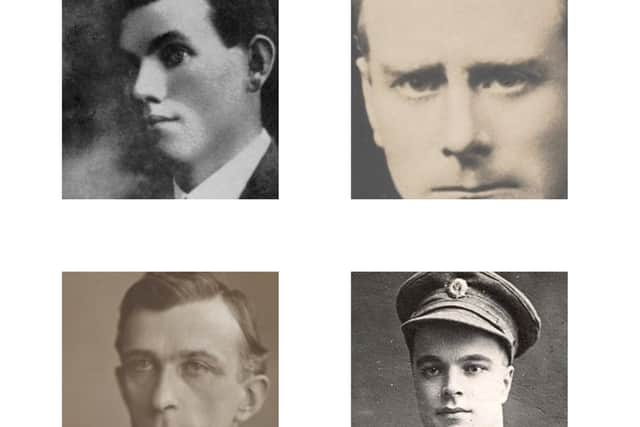Execution of O’Connor, Mellows, Barrett and McKelvey was ‘murder’ says Taoiseach Micheál Martin
and live on Freeview channel 276
They were among dozens of republican prisoners executed by the Free State during the course of the Irish Civil War.
The official justification for the killing was the assassination of the pro-Treaty T.D. Seán Hales, as he left the Dáil on December 7, 1922.
Advertisement
Hide AdAdvertisement
Hide AdIt has been said they were selected as representatives from each of the provinces. Joe McKelvey, who had served as Chief of Staff of the IRA in the summer of 1922, was from Stewartstown in Tyrone; Rory O’Connor, was from Dublin; Richard Barrett was from Cork; and Liam Mellows, though born in England and raised in Dublin and Wexford, was associated with his Galway constituency.


According to the testimony of one Derry republican a number of the executed leaders – not just McKelvey who was born in Tyrone – were familiar with the work of the IRA in Derry city.
Liam A. Brady, O/C, of the Derry Fianna from 1920 to 1922, recalled how, after the Truce that ended the War of Independence and the signing of the Anglo Irish Treaty, which was opposed by republicans, he had delivered a quantity of explosives to Liam Mellows in the Four Courts garrison, which had been occupied by the Anti-Treaty IRA from April 1922.
Mellows, O’Connor, McKelvey and Barrett were all arrested following the bombardment of the Four Courts by Free State forces at the end of June 1922.
Advertisement
Hide AdAdvertisement
Hide AdIn the early 1950s, Brady told the Bureau of Military History: “When the Truce came and the Anglo Irish Treaty was signed I was asked to come and bring a delegate with me to the Fianna Ard Fheis which was arranged to be held in a house in Parnell Square, Dublin.
“My 2nd Lieutenant, William Deeney was selected by our Derry Committee to come with me. He represented Derry City. while I represented County Donegal.”
According to Brady the Ard Fheis approved the position of the Army Council in relation to the Treaty and word to this effect was sent to the Four Courts.
Shortly afterwards he was dispatched to IRA headquarters with the explosives.
Advertisement
Hide AdAdvertisement
Hide Ad“The next day we visited Barney Mellows [Liam’s brother] at the Fianna Headquarters. He issued me with a pass to get in to the Four Courts and I had with me a 2 lb. sample of a new explosive known as ‘Bradyite’.
"I intended to give the formula along with the, sample to Liam Mellows who was in the Four Courts. When Willie Deeney and I arrived at the side gate we handed in our pass and were waiting to be admitted.
"The streets were packed with onlookers watching the work of the IRA fixing sandbags and other forms of fortification.”
There was a brief scare as a Free State patrol conducted a tour of the garrison.
Advertisement
Hide AdAdvertisement
Hide Ad"I left my sample with Barney Mellows and next day Deeney and I went on our journey back home to Derry.”
Brady claimed that two of the victims of the December 8, 1922 executions may have been in Derry at the time of the rescue of Frank Carty, O/C of the Tubbercurry Battalion of the IRA, in February 1921.
Carty was being held in Derry gaol due to his involvement in the Chaffpool ambush in Sligo in September 1920 when RIC inspector James Joseph Brady was killed but was sprung in what Brady described as the 'most sensational and daring' rescue on February 15, 1921.
"One of the most sensational and daring exploits of the IRA in the city was the rescue of Commandant Frank Carty from Derry Jail. On January, 30, 1921, four Volunteers, Captain Charles McGuinness J. Sheehy, B. Doherty and Dom [Doherty] were told to call at No. 4 Chamberlain Street.
Advertisement
Hide AdAdvertisement
Hide Ad"When they arrived there they found Paddy Shiels and four senior officers, Joe McKelvey and Dick Barrett were present? They were told that the job they had volunteered for was a very tricky and dangerous one,” Brady related, the senior IRA officers obviously keen to secure the release of Carty.
In Dáil Éireann, Taoiseach Micheál Martin this week described the executions as ‘murder’.
The killings were raised by the Fianna Fáil T.D. Christopher O’Sullivan, who said: “They were executed without trial or charge by the order of the Executive of the newly formed Free State Government.
"The executions were done as a reprisal for the sad and tragic killing of Deputy Seán Hales, a killing which these four men had no hand, act or part in. The event was described in a Dáil debate 100 years ago as, ‘Murder most foul, bloody and unnatural’.
Advertisement
Hide AdAdvertisement
Hide Ad"The State has never acknowledged that these killings were illegal or wrong. The Taoiseach has said these killings were murder by any definition. Today, almost 100 years since those executions, I ask that the Government finally acknowledge that these killings were manifestly illegal and wrong.”
The Taoiseach replied: “The murder of Seán Hales was a terrible crime, objectively, not from looking back now on the past. The Deputy is correct that the contemporary Dáil records show that it was an extremely traumatic and bitter time in our history, particularly the contribution from the late Thomas Johnson of the Labour Party, in a significant speech where he called it out that week. What happened to those four young men at that time was not in accordance with the law. As I said, it represented murder.”
